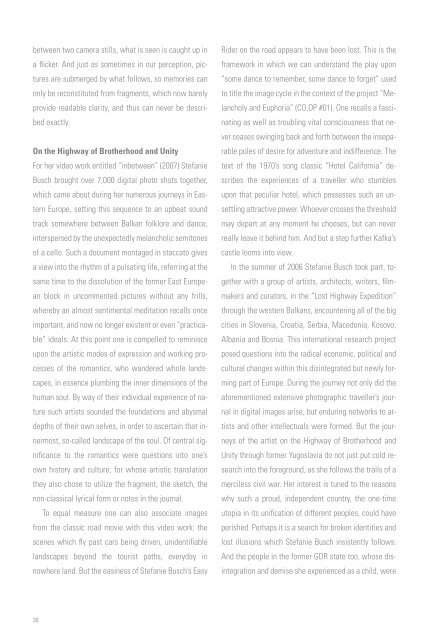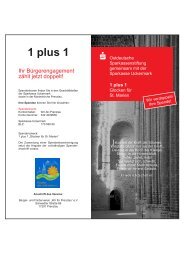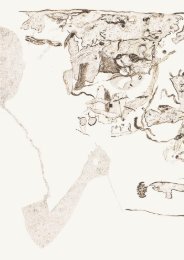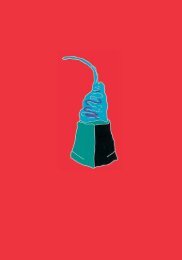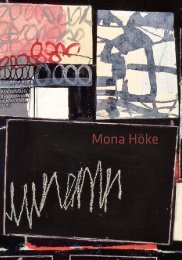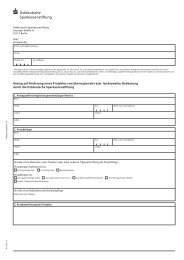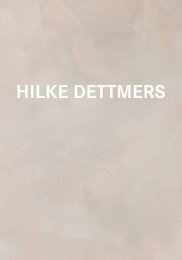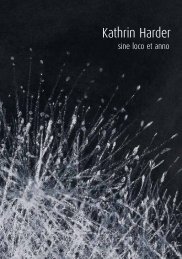Stefanie Busch - Ostdeutsche Sparkassenstiftung
Stefanie Busch - Ostdeutsche Sparkassenstiftung
Stefanie Busch - Ostdeutsche Sparkassenstiftung
Erfolgreiche ePaper selbst erstellen
Machen Sie aus Ihren PDF Publikationen ein blätterbares Flipbook mit unserer einzigartigen Google optimierten e-Paper Software.
etween two camera stills, what is seen is caught up in<br />
a flicker. And just as sometimes in our perception, pic-<br />
tures are submerged by what follows, so memories can<br />
only be reconstituted from fragments, which now barely<br />
provide readable clarity, and thus can never be descri-<br />
bed exactly.<br />
On the Highway of Brotherhood and Unity<br />
For her video work entitled “inbetween” (2007) <strong>Stefanie</strong><br />
<strong>Busch</strong> brought over 7,000 digital photo shots together,<br />
which came about during her numerous journeys in Eas-<br />
tern Europe, setting this sequence to an upbeat sound<br />
track somewhere between Balkan folklore and dance,<br />
interspersed by the unexpectedly melancholic semitones<br />
of a cello. Such a document montaged in staccato gives<br />
a view into the rhythm of a pulsating life, referring at the<br />
same time to the dissolution of the former East Europe-<br />
an block in uncommented pictures without any frills,<br />
whereby an almost sentimental meditation recalls once<br />
important, and now no longer existent or even “practica-<br />
ble” ideals. At this point one is compelled to reminisce<br />
upon the artistic modes of expression and working pro-<br />
cesses of the romantics, who wandered whole lands-<br />
capes, in essence plumbing the inner dimensions of the<br />
human soul. By way of their individual experience of na-<br />
ture such artists sounded the foundations and abysmal<br />
depths of their own selves, in order to ascertain that in-<br />
nermost, so-called landscape of the soul. Of central sig-<br />
nificance to the romantics were questions into one’s<br />
own history and culture, for whose artistic translation<br />
they also chose to utilize the fragment, the sketch, the<br />
non-classical lyrical form or notes in the journal.<br />
3<br />
To equal measure one can also associate images<br />
from the classic road movie with this video work: the<br />
scenes which fly past cars being driven, unidentifiable<br />
landscapes beyond the tourist paths, everyday in<br />
nowhere land. But the easiness of <strong>Stefanie</strong> <strong>Busch</strong>’s Easy<br />
Rider on the road appears to have been lost. This is the<br />
framework in which we can understand the play upon<br />
“some dance to remember, some dance to forget“ used<br />
to title the image cycle in the context of the project “Me-<br />
lancholy and Euphoria” (CO.OP #01). One recalls a fasci-<br />
nating as well as troubling vital consciousness that ne-<br />
ver ceases swinging back and forth between the insepa-<br />
rable poles of desire for adventure and indifference. The<br />
text of the 1970’s song classic “Hotel California” de-<br />
scribes the experiences of a traveller who stumbles<br />
upon that peculiar hotel, which possesses such an un-<br />
settling attractive power. Whoever crosses the threshold<br />
may depart at any moment he chooses, but can never<br />
really leave it behind him. And but a step further Kafka’s<br />
castle looms into view.<br />
In the summer of 2006 <strong>Stefanie</strong> <strong>Busch</strong> took part, to-<br />
gether with a group of artists, architects, writers, film-<br />
makers and curators, in the “Lost Highway Expedition”<br />
through the western Balkans, encountering all of the big<br />
cities in Slovenia, Croatia, Serbia, Macedonia, Kosovo,<br />
Albania and Bosnia. This international research project<br />
posed questions into the radical economic, political and<br />
cultural changes within this disintegrated but newly for-<br />
ming part of Europe. During the journey not only did the<br />
aforementioned extensive photographic traveller’s jour-<br />
nal in digital images arise, but enduring networks to ar-<br />
tists and other intellectuals were formed. But the jour-<br />
neys of the artist on the Highway of Brotherhood and<br />
Unity through former Yugoslavia do not just put cold re-<br />
search into the foreground, as she follows the trails of a<br />
merciless civil war. Her interest is tuned to the reasons<br />
why such a proud, independent country, the one-time<br />
utopia in its unification of different peoples, could have<br />
perished. Perhaps it is a search for broken identities and<br />
lost illusions which <strong>Stefanie</strong> <strong>Busch</strong> insistently follows.<br />
And the people in the former GDR state too, whose dis-<br />
integration and demise she experienced as a child, were


